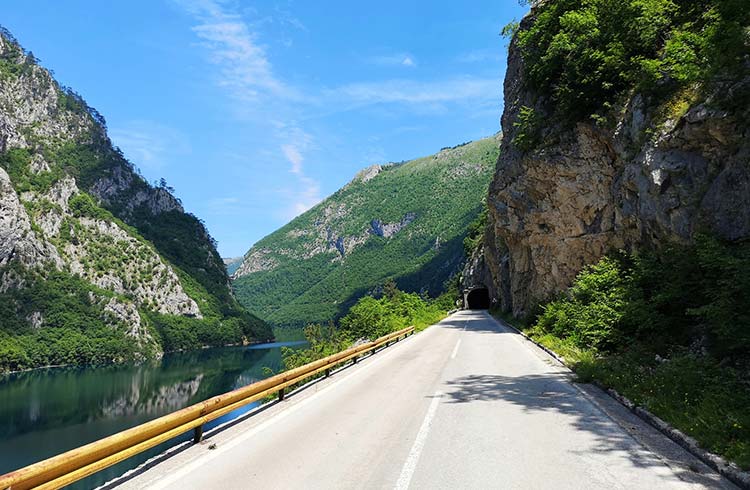Driving in the Balkans: Tips & Advice for Safer Road Travel
Before you drive in the Balkans region, find out about road safety, what to expect from drivers and road conditions. This is what you need to know.
 Photo © Getty Images/
Photo © Getty Images/
So, you want to take a road trip through the southern Balkans? From crowded roads to maniac behavior from some drivers, Balkan roads are reserved for unrelenting thrill-seekers. This is what you need to know before you hop in your hire car.
Safe driving in Macedonia
Let's start with the easy one. Most major roads in Macedonia are in decent shape, comparable to Western European countries. It's when you go to the little streets and country roads that the adventure begins. You'll be sharing it with horse carriages, pedestrians, livestock, roadkill, and the occasion debris from poorly-secured transport trucks.
Mountain roads, especially, are narrow, unmarked, and missing guardrails. At night and during bad weather they can be quite dangerous.
In the cities, you'll be competing with devoted speeders who see red lights and stop signs as decoration. They might make left turns from the far right lane, cutting you off suddenly. Old, dilapidated cars could break down in a blink. Some are missing headlights and rear lights. Since many streets are poorly lit, night driving is especially risky.
This is all to say: drive defensively at all times.
If you want to visit the areas close to the Serbian border, you must obtain permission form the Macedonian authorities, since most of that area is a military zone. Exceptions are made if travelling on the main highway towards designated border crossings.
All tolls must be paid in denars, the local currency.
Road trip safely in Montenegro
Things start getting a little hairier in Montenegro. Almost everything about Macedonia applies, and a bit more.
Defensive driving is, again, a must. Winding roads carry a special thrill, since Montenegrin drivers think nothing of passing on blind turns and hills. One road called the Moraca Canyon in the south has been enshrined into legend. Narrow and twisting, it runs through rocky tunnels and viaducts. And it's always crowded in the summer. In winter, it's covered with snow, making it prone to slow traffic and accidents.
On the coast road conditions are better but also crowded. The speed limit is 80 kmh on open roads and 50 km/h in the city. Excessive speeding, which is going 30 km/h over the limit, can get your licence confiscated.
The use of safety belts is mandatory, and so is keeping your lights on at all times. It seems that many roads are perpetually under construction, so be ready for delays and detours.
Watch out for pedestrians. Montenegrins are unabashed jaywalkers. And since yelling is a part of everyday conversation, don't be alarmed if you get shouted at. It's entirely normal.
There are hardly any tollbooths in the country, and it's all in euros.
On the roads in Kosovo
Naturally, we saved the best for last. Kosovar roads are for the adrenaline junkies blessed with infinite patience. Most things noted above apply: rural roads are decrepit and burdened with farm animals. Constant road work can slow traffic to a crawl.
Pedestrians in Kosovo quickly learn to be agile, since cars don't seem to ever stop for them.
Interestingly, speed limits are strictly enforced. There have been reports of cars with foreign plates being stopped by police for bogus traffic violations. Officers allegedly demand immediate cash payment. If this happens to you, be polite yet firm. Demand a full explanation. If none is forthcoming, request permissions to call your embassy.
Tolls are paid in euro, the national currency. Cars with foreign licence plates must pay for compulsory Green Card insurance, or buy insurance at the border.
During heavy rains there is a small risk of landslides on the road between Prishtina and Skopje, in Macedonia.
If renting a car, know that rental companies in Serbia won't let you drive into Kosovo, and vice-versa. Although chances of an incident are slim, there have been a few cases where cars with Serbian plates were targeted for attack in isolated region of Kosovo.
If taking public transport, know that vehicles are old and usually crowded. There are occasional disruptions in the bus service. Rail services are generally of low quality.
Only use officially marked taxis and demand that the driver use the meter. If there is none, negotiate the fare before getting in.
Simple and flexible travel insurance
You can buy at home or while traveling, and claim online from anywhere in the world. With 150+ adventure activities covered and 24/7 emergency assistance.
Get a quote
No Comments